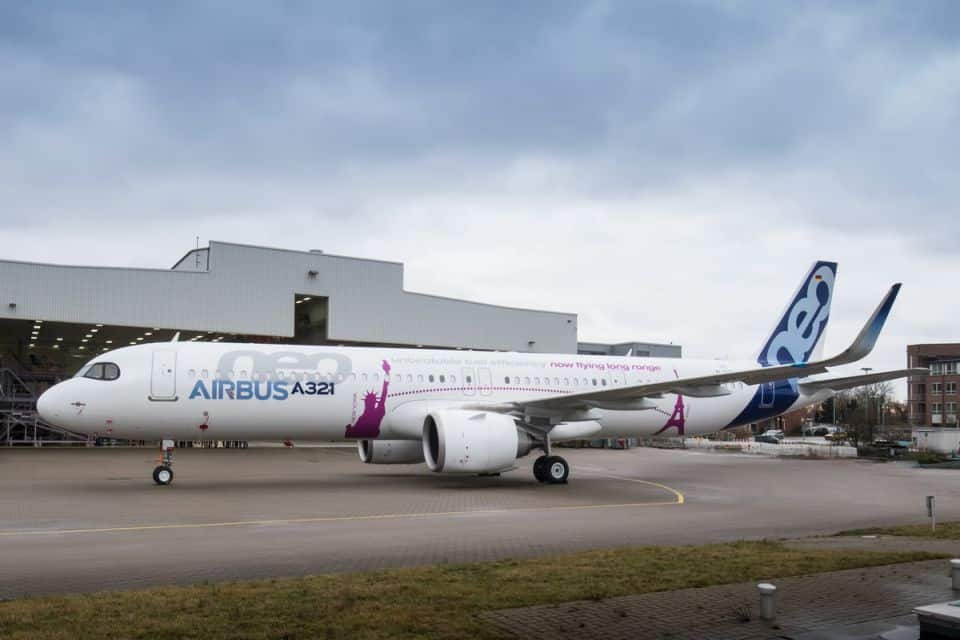Aerospace
Airbus starts A321 aircraft production in China’s Tianjin
Airbus starts A321 aircraft production in China’s Tianjin

At its Final Assembly Line Asia (FALA) facility in Tianjin, north China, the European aircraft manufacturer Airbus began producing A321 aircraft on Wednesday, demonstrating that China is capable of supplying all models of Airbus’ A320 family of aircraft.
Airbus and partners embark on SAF deliveries in China(Opens in a new browser tab)
Early next year is anticipated for delivery of the first A321 built in Tianjin. As of right now, the company’s backlog of A321 aircraft makes up about 60% of its whole global backlog for the A320 series of aircraft. The single-aisle A321 variant can carry more than 200 passengers and can travel long distances with the same capacity as a wide-bodied aircraft, but at less expensive operating costs.
China’s 14th Five-Year Plan (2021–25) projects that by 2025, the nation’s civil aviation industry will transport 930 million passengers and 9.5 million tonnes of cargo and packages annually. By 2025, there will be more than 70 countries and regions connected to China by air, and more than 50 of them will be partners in the Belt and Road Initiative.
Three missions, one aircraft: Airbus A400M shows its potential in the UK(Opens in a new browser tab)
By beginning A321 production, Airbus has conveyed encouraging messages to China, according to Zhang Yi, an associate professor at the Economic and Management College of the Civil Aviation University of China. Zhang said he thinks it demonstrates the assurance and optimism of Airbus and other European businesses on the swift recovery and expansion of Asia’s aviation sector.
Despite having a big population, China’s aviation sector has significant potential because the number of yearly air passenger flights per person in the nation is less than 0.5, compared to a rate of about 2.5 for developed nations.
Over the next two decades, China will continue to be the world’s largest market for new aircraft. “Of the nearly 4,000 commercial aircraft in the Chinese market, 2,100 Airbus aircraft account for more than 50% of the total,” added Xu. According to him, Airbus’ growth in China has been made possible by the country’s civil aviation industry chain’s development.

Aerospace
When Ratan Tata was denied entry to the airfield at the Aero India show, he waited

During our visit to Aero India 2019, we had the unexpected opportunity to see Ratan Tata at the event, which was a thrilling moment for us. However, there was a surprising hiccup when the security staff didn’t allow him to enter due to a lack of a security pass.
Despite this, he remained calm and patiently waited for about 20 minutes until a member of the Tata team brought him the required pass, after which he calmly proceeded inside. It was a humbling sight, showcasing his composed demeanor even in such situations.
Ratan Tata ji is not only a renowned industrialist but also a trained pilot, holding a pilot’s license. In 2007, he became the first Indian civilian to fly the F-16 Falcon during the Aero India show in Bangalore—a proud moment for the nation.
His passion for aviation extended beyond flying, as he played a key role in shaping India’s aerospace industry. Under his leadership, Tata ventured into manufacturing and maintaining aerospace components while upholding its legacy of quality. Notably, Tata’s collaboration with Airbus to develop and manufacture the C295 aircraft is a testament to its growing influence in the sector.
-

 Aviation2 months ago
Aviation2 months agoMicrosoft Flight Simulator Raises $3 Million to Bring Back the An-225 Mriya
-

 Airlines2 months ago
Airlines2 months agoQantas Engineers Stage Walkout Over Cost of Living Concerns
-

 Airlines2 months ago
Airlines2 months agoQatar Citizens Can Travel to the United States Without a Visa
-

 Aviation2 months ago
Aviation2 months agoQatar Airways bans these new Electronic Devices on plane
-

 Airlines2 months ago
Airlines2 months agoJapan Airlines Rolls Out Free Domestic Flights to International Passengers
-

 Defence2 months ago
Defence2 months agoWhich Country Has the Largest Fleet of Fighter Aircraft?
-

 Airport2 months ago
Airport2 months agoWestern Sydney Airport Welcomes Its First Plane After 6 Years of construction
-

 Aviation2 months ago
Aviation2 months agoDid you know ? Once Boeing 747 carried 1088 passenger in 1991








